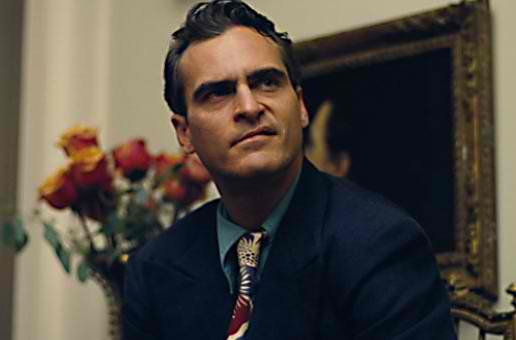Paul Thomas Anderson’s “The Master” is a totally exhausting, fully encompassing movie about dangerous people. This much anticipated film will show at the Venice Film Festival on Saturday–and it’s going to be the topic of every conversation after that.
“The Master” is a dangerous movie. I can’t remember a time in recent memory when I worried about what characters might do when they entered a scene. But when Joaquin Phoenix comes into a frame or scene at any time in “The Master,” you’re really concerned he’s going to hit or kill somebody, or do something utterly wild and unpredictable. His character, Freddie, is an alcoholic and a sociopath. Freddie has just been discharged from the Navy at the end of World War II. He’s a sexual deviant, who we learn later was abused by an aunt. Freddie is also a loner, a drifter whose temper is so bad he can’t hold a job. And then he meets Lancaster Dodd, and his life changes completely.
Dodd is played by Philip Seymour Hoffman. He comes with a family–wife Amy Adams, a daughter and son in law, and a son. What is Dodd? He says he’s a writer and a nuclear scientist, among other things. But he’s also already come up with his own religion, a cult called The Cause. His own son says later that Dodd is just making it up as he goes along. But his wife is sold and is his collaborator. The son in law sees opportunity in it as well. And soon The Cause picks up a couple of wealthy female patrons, played by Patty McCormack (star of “The Bad Seed” in the 1960s) and the much missed Laura Dern. (I wish she were in more movies. She’s spot on.)
There’s so much going on in “The Master,” you almost need two hours and 17 minutes to dissect it. It’s a gritty, edgy, uncomfortable film marked by Freddie’s deviancy and Dodd’s avuncular unease. Phoenix and Hoffman are completely riveting, never once hit a false note, and keep the action moving. Amy Adams peels back a new side of her very interesting, onion like sensibility. She seems to always have new tricks to show us. Knowing that Hoffman and Phoenix are show stoppers, Amy works along the edges until she sees her moment. She’s absolutely terrific.
The Cause is not Scientology per se. But it mimics it. The courses are called “Applications.” There are kind of EEG machines. There’s a violence to the Cause, mostly instigated by Freddie, that has been associated with Scientology. I was reminded of a lot of things– including Oprah tearing up every time a new New Age guru stops by with a book of aphoristic gobbledygook. Dodd knows he’s making it up as he goes along. Wait for the scene when Dern meekly questions something in his book. He’s contradicted an earlier stand. Dodd–Hoffman–loses it, and we get a glimpse into his Machiavellian mind.
But the sham that is The Cause is unveiled–at least for the audience. When Hoffman/Dodd finally reveals his big discovery–what will change everyone’s lives–you just shake your head. It’s as mundane as the stuff that comprises other cults’ revelations. The emperor has no clothes.
And while Hoffman and Phoenix are pungent, they never drift into cliche. There’s no scene chewing. Hoffman, who could have played the cartoon heavy, instead finds Dodd’s soul. He’s no routine huckster. His performance reminded me a little of Michael Caine’s abortionist doctor in “Cider House Rules.” He knows, we know, he’s doing something over the line, but we’re kind of cheering for him. Hoffman could not be better cast, and it’s best work ever with Anderson after films like “Boogie Nights” and “Magnolia.”
Phoenix bends his body into a malformation and seems to be listening to signals from beyond Neptune. Phoenix seems to transform his own body shape as Freddie. He looks almost like a human pretzel. You can tell Freddie is in pain physically and mentally throughout. Phoenix is rather astonishing at conveying Freddie’s mystery and loss.
And then you have the cinematography. Mihai Malaimare Jr. has worked on the last three mostly lamentable Francis Ford Coppola movies. He doesn’t have a long resume. But there more than a dozen different examples of artistry at work in “The Master.” His framed shots are mini masterpieces. Also to be cited: Johnny Greenwood’s extraordinary dissonant score. It’s as if Anderson dreamt Greenwood, clanging on odd percussives to punctuate scenes.
Some early viewers said on the internet they were confused, or that the movie was dreamy. Others compared it to Terrence Malick. I disagree on both counts. The story was easy enough to follow. And it was ethereal when it was supposed to be, explicit at other times. It’s not an easy movie, it’s not “The Artist” or “The King’s Speech” in that it’s happily embraceable. “The Master” is very sophisticated, mature filmmaking. I’m glad they’re releasing it on Septmber 14th. It’s going to take at least two months for every one to digest it and discuss it before the cacaphony of awards season starts. But look out, because the main trio, and Anderson, Greenwood, and Malaimare are going to be players this winter.

